| The Great Ice Storm of 1886 |

SEACOAST NH HISTORY
January 28-29, 1886
Telegraph and telephone lines were torn down. Tree limbs could be heard crashing to the ground for two days after the great ice storm. Many of the city's beautiful shade trees collpased under the weight, as much as three pounds of ice for a single ounce of tree branch. Luckily the local Davis Brothers photo team was on the job to create these images of "the storm of the century".
SEE another 1886 photo
EARLY DAVIS BROS PHOTOS
& Three Newspaper Accountants
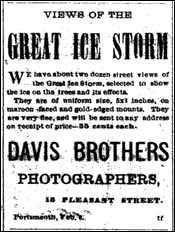 They called it the ice storm of the century. Amazingly, the images of snow and broken trees show how little downtown Portsmouth has changed in over a century. These images were quickly captured by the Davis Brothers and the Newell Company, competing photographers who provided pictures the Victorian newspapers could not supply.
They called it the ice storm of the century. Amazingly, the images of snow and broken trees show how little downtown Portsmouth has changed in over a century. These images were quickly captured by the Davis Brothers and the Newell Company, competing photographers who provided pictures the Victorian newspapers could not supply.
Within days of the storm the mounted photos became available in downtown shops for 35 cents apiece. These scenes come to us courtesy of the Portsmouth Athenaeum and the Portsmouth Public Library. We've attached three intriguing 1886 newspaper articles that bring the pictures to life. (JDR with newspaper research by Richard Winslow III)
SEE: One more Ice Storm photo
Click to read each article below, scroll down for photos To read captions, place your mouse over the photo.
THE ICE STORM
Reprinted from the Portsmouth Chronicle
Friday January, 29 1886
DESTRUCTIVE BEAUTY
Reprinted from the Portsmouth Daily
Evening Times Friday January 29, 1886
ICE BOUND
Reprinted from The Portsmouth Journal
Saturday, February 6, 1886


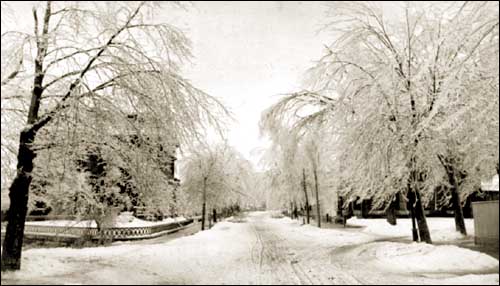
Photos courtesy of the Portsmouth Athe naeum. All rights reserved.
CONTINUE for more ICE STORM 1886 PHOTOS
Davis Brothers, Portsmouth, NH (continued)
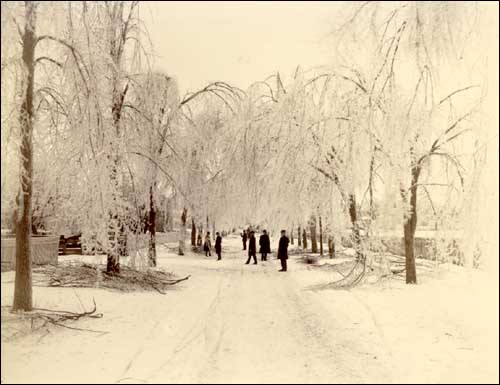
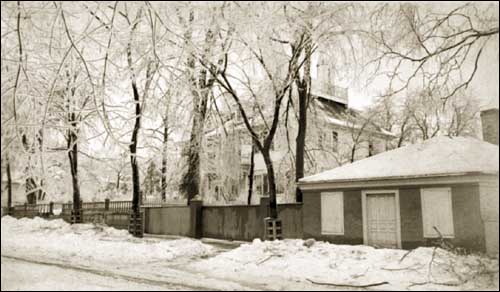
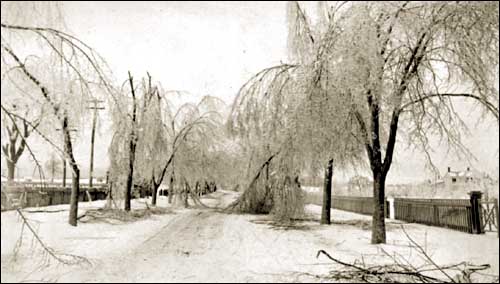
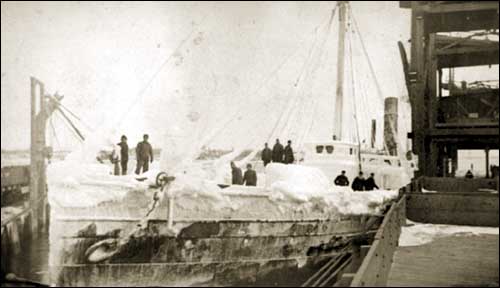
Photos courtesy of the Portsmouth Athenaeum. All rights reserved.
NOW READ: Three Eye-Witness Accounts from 1886
Click Below to Continue
EYEWITNESS ACCOUNT, Portsmouth, NH (continued)
THE ICE STORM
Reprinted from the Portsmouth Chronicle
Friday January, 29 1886
Never within our recollection were the trees throughout the city so completely and heavily coated with ice, from the ground to the tips of the smallest twigs, as they were Thursday morning; not only were the upper sides of the limbs sheeted with ice, but all along the under sides, about an inch apart, were millions of tiny icicles an inch or two in length and as big around as pipestems. The aggregate weight of all this, on a large tree, was immense, and all through the day and all over the city the crashing of falling branches could be heard, dead and living limbs alike yielding to the unusual strain put upon them. If there was any difference, the more vigorous and thrifty trees suffered the most, as they presented a greater number of twigs for the ice to cling to. The street commissioner's men, with all the available teams, at an early hour commenced work at clearing the streets of the fallen limbs, and were kept at it til night; but with all their efforts there was hardly a street that was absolutely clear of obstructions for an hour during the day.
Telephone, telegraph and fire (unreadable here) wires were not slighted, and could be seen many hundreds of feet away in bars of ice. Closer examination showed that like the limbs of trees they were sheathed with ice on top and at the sides, and underneath were ornamented with millions of little icicles about an inch apart. The wires were in many places hanging in festoons nearly to the ground, or lying flat on the ground, and the damage from this cause must have been serious.
Were we to attempt giving the names of the streets where the trees suffered badly, we should have to give a list of all the streets in the city where there are any trees to speak of. Great injury was done in the south cemetery, particularly to the trees in the vicinity of the pond. The trees at the southerly end of Richards avenue, the big and thrifty elms on Middle, South and Pleasant streets, the elms and maples on Elm and Islington streets, and elms and horse chestnuts on State, Daniel and Linden streets, were badly used, some fine ones being ruined by the tearing off of large limbs and many fruit trees in gardens about the city were wholly destroyed or badly damaged.
Not much harm was done by the falling limbs, so far as was reported up to Thursday evening. A few telephone wires were snapped, a few windows broken, and a gas-post in front of the high schoolhouse demoralized, but no person was reported as having sustained any injury.
The walking was about as bad as it could possibly be; the sidewalks were slippery as greased glass, and the middle of the streets not much better. The "no school" signal was sounded by the fire alarm at eight o'clock and 11:30, the school board very sensibly deciding that the children would be better off at their homes than tumbling about in the streets. As the day advanced the snow in the streets became waterlogged slosh, but neither the walking nor sleighing was improved thereby.
The few persons who drove into the city from surrounding towns during the day reported the roads in some places nearly impassable, owing to trees being so borne down that their branches were close to the ground in the highway while many broken limbs obstructed travel.
Altogether, the damage done by the storm of sleet on Wednesday night and Thursday must have amounted to many thousands of dollars in this city and its immediate vicinity; and worse than this, it will be many years before the shade and garden trees can recover the symmetrical beauty they possessed last summer.
When night arrived there was not a street in the city in which there is a tree that did not have piles of branches along the sides, where they had been tumbled by the city workmen so as to leave the driveway and walks as clear as possible. The street lights were by order of Mayor Eldredge kept burning all Thursday night, and several strong gangs of extra hands were kept at work through the night clearing away the wreak.
CONTINUE for EYEWITNESS ACOOUNTS of the storm
EYEWITNESS ACCOUNT, Portsmouth, NH (continued)
DESTRUCTIVE BEAUTY
Reprinted from the Portsmouth Daily
Evening Times Friday January 29, 1886
The ghostly pictures which today adorn our streets and the landscape are but the reproduction of those of some forty years ago. Fortunately it is only at long intervals that the conditions are just right for the best work of the artistic icy fingers of old winter. While we deprecate the wasteful extravagance of nature in its severer aspect, that destroys the beautiful work which has occupied summer years to bring to perfection, yet all the same the work of the arctic artist commands our admiration. Those who happened to walk our streets last night at the midnight hour, can best appreciate the strange, weird beauty of the scenes. The glittering trees reflecting the gas lights, presented the effect of bowers of diamonds, rivaling the beauties of the far-famed Alhambra, or the most startling productions of Alladin's lamp. Every object was brilliant with reflected light; the telegraph wires drooping in graceful festoons, were decorated with deep fingers that fashionable ladies might be proud to wear; the heavy tassels of the evergreens swung down over the pavements in rich profusion. From the street lanterns hung pendants of silver, and ordinary fences were radiant with nature's silver varnish. Could some of our photographic artists have caught the beauties of the scene, the pictures might serve instead fans in the hot days of next July. Fortunately these winter scenes are evanescent, and will we hope soon take their departure, not standing upon the order of going.
The destruction was universal in nearly all parts of the city. The elms and willows felt the force of the destroyer more than other trees, being less able to sustain the many tons of ice sticking to their many branches. All of this sort of beautiful shade trees fared alike, the uppermost branches breaking off and crashing through the lower limbs, making sad havoc of their naturally symmetrical beauty. The grandest sight and the most effectual destruction we saw this morning was the Richards Avenue, where the elms growing on both sides of the street having been justly considered beautiful, are now left with the ragged stumps of limbs reaching skyward, while many smaller limbs, bending under load of ice meet overhead, almost touching the ground, and making it somewhat difficult and even dangerous to drive through. Large limbs lay stretched across the driveway in many places, and numerous brush heaps, gathered by the city workmen, were evidence of the work of destruction which had gone on during yesterday. The scene, although accompanied by so much devastation, was grandly beautiful, and was inspected by many citizens. Two of our photographers were on the spot and took numerous views, an opportunity for which work may not again be offered for many years.
CONTINUE for EYEWITNESS ACOOUNTS of the storm
EYEWITNESS ACCOUNT, Portsmouth, NH (continued)
ICE BOUND
Reprinted from The Portsmouth Journal
Saturday, February 6, 1886
The remarkable storm of last week, which destroyed many of our finest shade trees, merits more than a passing mention. On Wednesday a fine, misty rain began to fall from warmer strata of the atmosphere, upon the earth, which was evidently surrounded with a thin layer of cooler air next its surface, not sufficiently thick to congeal the falling rain in its descent. Soon the trees and other exposed places were covered with a coating of smooth ice, which gradually thicked by accretion as the minute drops fell upon the icy surface until twigs the size of whiplashes had become an inch or more in diameter. Every twig being covered with this icy envelope, a great weight was thus imposed upon the branches, and on Thursday morning it was found that many branches had yielded to the pressure and had either broken off or hung down apparently laden with immense crystals of rock candy. All day Thursday and Friday and until Saturday morning the crash of breaking branches was heard. Some of the streets were so obstructed with the pendant branches, that driving was almost impossible. Magnificent branches of perfectly sound wood, a foot or more in diameter were wrenched off by the enormous weight of the pendant masses of ice, which possessed a greatly increased power by operating in every case at the end of a long lever, by means of which the ice, itself being very heavy, being perfectly clear without air bubbles, multiplied its destructive force many times, and became irresistible. In this way many fine shade trees were encumbered with fallen branches and the lives of pedestrians were threatened by numerous broken branches just ready to fall, and overhanging the sidewalks like the sword of Damocles. The elms, poplars and willows suffered most, though all kinds of trees were more or less injured.
We hear of a gentleman in a town a few miles from the ocean, who took an ordinary twig and weighed it in its coating of ice. It weighed forty ounces. Without the ice it weighed one ounce. We should suppose the proportional weight was even heavier than this in many cases. Some twigs not more than one-eighth of an inch in diameter, when coated with ice were at least an inch and a quarter in thickness. A simple proportion will show that its bulk was thus increased at least one hundred fold, and it weight must have increased in still greater proportion. On Saturday a gentle thaw removed a part of the icy covering, and very fortunately, for had it not been for that relief the snow which fell between Saturday and Sunday would have been the unbearable feather to numerous branches. As it was on Sunday, Monday, Tuesday and Wednesday, the trees which before had shone with pendant crystals, were covered thickly with a white fleecy mantle of snow over the ice-clad branches, and as we go to press the ice remains thick on some branches. This state of affairs seems to have existed in Maine, New Hampshire, and Massachusetts. Portland, Portsmouth, and Newburyport suffering as much as any places. It was extremely fortunate that a calm prevailing during all this time, else all the trees would have been stripped of their branches, and the ruin, even now, great, would have been universal.
